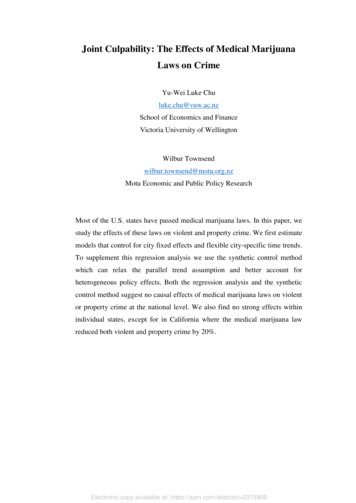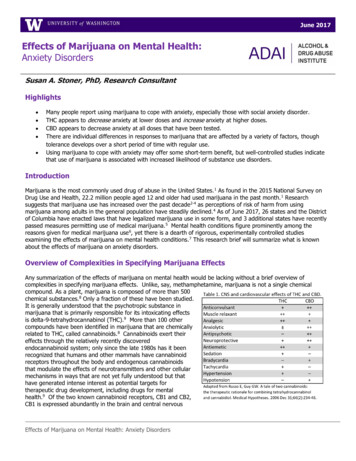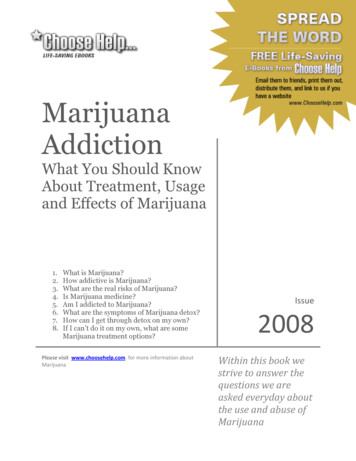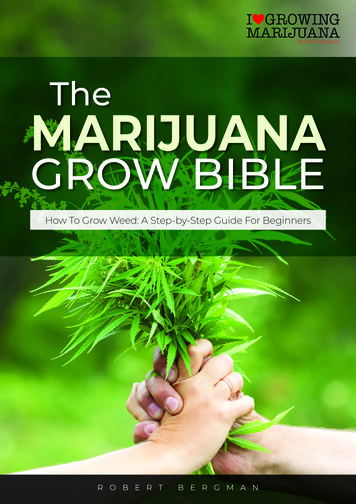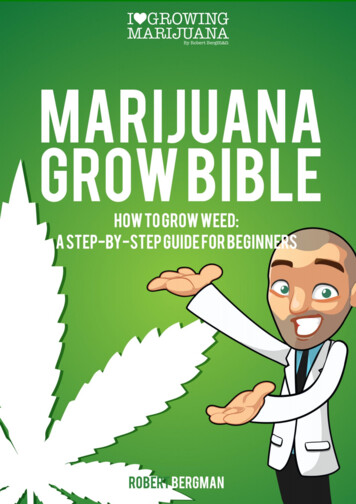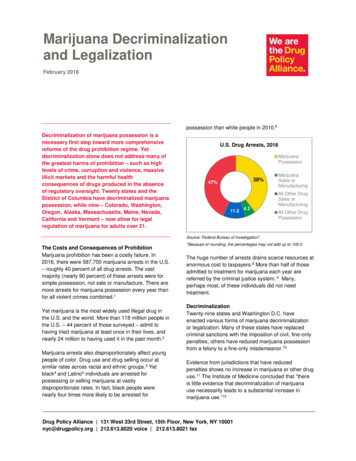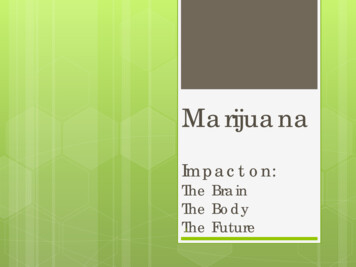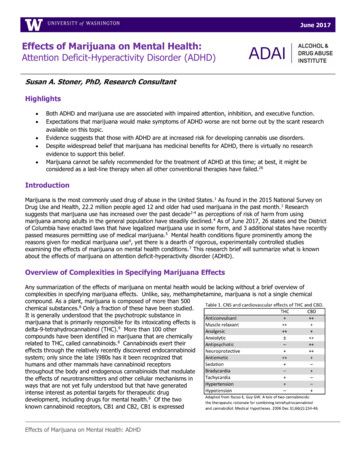
Transcription
June 2017Effects of Marijuana on Mental Health:Attention Deficit-Hyperactivity Disorder (ADHD)Susan A. Stoner, PhD, Research ConsultantHighlights Both ADHD and marijuana use are associated with impaired attention, inhibition, and executive function. Expectationsthat marijuanawouldmake symptoms of ADHD worse are not borne out by the scant researchConsideringLocked vs. UnlockedTreatmentFacilitiesavailable on this topic. Evidence suggests that those with ADHD are at increased risk for developing cannabis use disorders. Despite widespread belief that marijuana has medicinal benefits for ADHD, there is virtually no researchevidence to support this belief. Marijuana cannot be safely recommended for the treatment of ADHD at this time; at best, it might beconsidered as a last-line therapy when all other conventional therapies have failed.26IntroductionMarijuana is the most commonly used drug of abuse in the United States. 1 As found in the 2015 National Survey onDrug Use and Health, 22.2 million people aged 12 and older had used marijuana in the past month. 1 Researchsuggests that marijuana use has increased over the past decade 2-4 as perceptions of risk of harm from usingmarijuana among adults in the general population have steadily declined. 4 As of June 2017, 26 states and the Districtof Columbia have enacted laws that have legalized marijuana use in some form, and 3 additional states have recentlypassed measures permitting use of medical marijuana. 5 Mental health conditions figure prominently among thereasons given for medical marijuana use 6, yet there is a dearth of rigorous, experimentally controlled studiesexamining the effects of marijuana on mental health conditions. 7 This research brief will summarize what is knownabout the effects of marijuana on attention deficit-hyperactivity disorder (ADHD).Overview of Complexities in Specifying Marijuana EffectsAny summarization of the effects of marijuana on mental health would be lacking without a brief overview ofcomplexities in specifying marijuana effects. Unlike, say, methamphetamine, marijuana is not a single chemicalcompound. As a plant, marijuana is composed of more than 500chemical substances.8 Only a fraction of these have been studied.It is generally understood that the psychotropic substance inmarijuana that is primarily responsible for its intoxicating effects isdelta-9-tetrahydrocannabinol (THC).9 More than 100 othercompounds have been identified in marijuana that are chemicallyrelated to THC, called cannabinoids.8 Cannabinoids exert theireffects through the relatively recently discovered endocannabinoidsystem; only since the late 1980s has it been recognized thathumans and other mammals have cannabinoid receptorsthroughout the body and endogenous cannabinoids that modulatethe effects of neurotransmitters and other cellular mechanisms inways that are not yet fully understood but that have generatedintense interest as potential targets for therapeutic drugdevelopment, including drugs for mental health.9 Of the twoknown cannabinoid receptors, CB1 and CB2, CB1 is expressedEffects of Marijuana on Mental Health: ADHD
abundantly in the brain and central nervous system (CNS) while CB2 expression is low in the CNS but high inperipheral immune cells and tissues.10 Psychoactive effects of marijuana are attributed to CB1 receptors whereas CB2receptors are non-psychoactive.9, 10Aside from THC, the most studied phytocannabinoid is cannabidiol (CBD). 11 CBD has been described asnonpsychotropic due to the fact that it appears to be non-intoxicating and non-reinforcing, but it does appear to bepsychotropic insofar as it appears to have pharmacological benefits with regard to anxiety, schizophrenia, addiction,and depression.12 Table 1 summarizes the major CNS and cardiovascular effects of THC and CBD. 11 CBD has beendemonstrated to attenuate certain effects of THC, including intoxication, sedation, and tachycardia. 11 In modernclinical trials, this has permitted the administration of higher doses of THC in an effort maximize therapeutic effectswhile minimizing side effects.11 It is largely unknown how the interaction of THC and CBD plays out in practical use ofmarijuana by medicinal and recreational marijuana users.Research on cannabis productsseized by the US Drug EnforcementAgency (DEA) shows that thepotency of marijuana in common usehas increased dramatically in the last2 decades, at least in terms of THCcontent.8 As shown in Figure 1, from1995 to 2014, the average THCcontent of seized cannabis productsvirtually tripled from approximately4% to approximately 12%.8 On theother hand, average CBD content fellfrom approximately 0.28% in 2001 to 0.15% in 2014, resulting in achange in the THC:CBD ratio of 14:1in 1995 to approximately 80:1 in2014.8 This means that, on average,the cannabis products seized in 2014were presumably far moreintoxicating and than those seized in 1995 – and marijuana and cannabis products that are in common use may bearlittle resemblance to marijuana supplied by the federal government for marijuana research.13 In terms of strength, theNational Institute on Drug Abuse considers less than 1% to be low, 1-5% to be medium, 5-10% to be high, and over10% to be very high.14 An examination of the online menu of one of Seattle’s most popular recreational marijuanastores in June 2017 listed over 100 varieties of marijuana “flowers” that were labeled as 20% THC or higher, with THCcontent going as high as 30%. For many of these, CBD content was not listed. By comparison, there were only 20varieties with listed THC content under 10%. Marijuana concentrates were labeled as having THC content as high as97%. From a scientific standpoint, the effects of cannabis products with such levels of THC on mental health havelargely not been studied.Individual differences in objective and subjective effects of marijuana vary by individual, variety/strain, dosage, routeof administration, personality, degree of tolerance, and other factors.9 Many of the psychological effects of cannabisand THC are biphasic and bidirectional.9 Acute marijuana intoxication is generally associated with euphoria, subjectivequickening of associations, relaxation, decreased motor activity, a sense of calm, increased awareness of sensoryexperience and internal sensations of the body, transient sensory experiences, synesthesia, craving sweet and saltyfoods, enhanced perception of current activities, increased salience of stimuli, simultaneous focus on multiple things,impaired shifting of focus, fantasies of power, and belief of having arrived at a transcendent insight. 15 With regard toneurocognition, marijuana intoxication is associated with deficits in processing speed, attention, working memory,decision-making, motivation, time-perception, and reality testing.15 Considering the broad range of effects, one canbegin to imagine how marijuana could have beneficial or harmful effects with regard to mental health.Tolerance to certain effects of marijuana develops with regular use, within several days in some cases, 9 as a functionof CB1 receptor expression downregulation.10 Research suggests that after tolerance develops it can take severalEffects of Marijuana on Mental Health: ADHD2 Page
weeks of THC-free recovery for CB1 receptor expression to return to baseline levels.10 Because of tolerance, theeventual downregulation of CB1 receptors with chronic use means that any benefit derived from THC with regard tomental health could result in symptom exacerbation when users are not under the influence of THC.10The Role of the Endocannabinoid System in ADHDIt is unknown precisely how the endocannabinoid system (ECS) may be involved in ADHD. A small preliminary studyfound that degradation of the endocannabinoid anandamide (AEA) was impaired in a small sample of drug-free boyswith ADHD.16 AEA impairs memory and attention by reducing the activity of the dopamine transporter system. TheECS may also be involved in ADHD through its involvement in reward circuits in the brain. 10Effects of Marijuana on CognitionMarijuana intoxication has well-documented deleterious effects on cognition, including impairments in attention andinhibition, verbal learning and memory, working memory, executive function, and psychomotor function. 17 Adults whouse marijuana chronically have demonstrated poorer performance on tests of attention, executive functions, learningand memory, visuospatial skills, and processing speed. Adolescent marijuana users show attention, working memory,and learning abnormalities that persist at least 6 weeks following cessation of use, but that these deficits may resolvewith longer term abstinence.18Most relevant to ADHD, impaired attention is generally considered a hallmark of being under the influence ofmarijuana. Numerous studies have demonstrated dose-dependent impairments in focused, divided, and sustainedattention tasks that may be attenuated with tolerance among daily users. Active adolescent and adult marijuana usersas well as those abstinent for several weeks show impairments on measures of sustained and divided attention,processing speed, rapid visual information processing, visual search, tracking, trail making, and paced serial addition.Increasing abstinence is generally associated with improvements in performance. 17Executive functions are differentially affected by acute and chronic exposure to marijuana. Several studies havedemonstrated impairments in planning, reasoning, interference control, and problem solving tasks with administrationof THC. With regard to the chronic effects of marijuana, findings on executive function are less consistent. Studies inwhich executive dysfunction was detected tended to have older samples than the studies in which no impairmentswere observed, which included predominantly adolescent and young adult users.17Effects of Marijuana on Cognition in ADHDFew studies have investigated the neurocognitive performance of individuals with both a history of ADHD and regularmarijuana use. Tamm et al.19 compared young adults with a childhood ADHD diagnosis who did (n 42) and did not(n 45) report marijuana use at least monthly in the past year to a normative comparison group (controls) who did(n 20) and did not (n 21) report past year regular marijuana use on neuropsychological measures. Findings indicatedthat ADHD group performed worse than controls on measures of verbal memory, processing speed, cognitiveinterference, decision-making, working memory, and response inhibition. There were no significant effects formarijuana use in either group, and no interactions between ADHD and marijuana use were found. A small study of theeffects of ADHD and marijuana use on brain functional architecture in young adults with a similar experimental designproduced similar findings that marijuana use does not exacerbate ADHD-related functional alterations in brainarchitecture.20Opinions on Therapeutic Use of Marijuana by those with ADHDClinical and anecdotal evidence suggest an increasingly popular perception that marijuana use is therapeutic forADHD. A qualitative study of online forum threads regarding ADHD and marijuana found a disproportionate numberof comments favoring the therapeutic over harmful effects of marijuana for ADHD that was specific to ADHD and notobserved when mood, non-ADHD psychiatric conditions, or general quality of life were considered. 21 Commentsextolling the therapeutic effects of marijuana for ADHD predominantly pointed to improvement in inattentivesymptoms rather than symptoms of hyperactivity or impulsivity. A number of comments indicated that marijuana wasEffects of Marijuana on Mental Health: ADHD3 Page
perceived as being “medicinal” or sanctioned by healthcare providers. Findings suggest that patients seekinginformation regarding effects of marijuana on ADHD will find information on Internet forums biased toward marijuanaimproving ADHD that is not reflective of what is found in the medical and research literature.Interestingly, a qualitative study of marijuana users in Norway (where marijuana use is illegal) found that aconsiderable proportion of participants reported that they used marijuana for what they perceived as medical reasons,and self-diagnosed ADHD was most prevalent. Traditional ADHD medication was described as having many morenegative effects than marijuana. Marijuana use was perceived as reducing symptoms associated with self-diagnosedADHD, and these effects were taken as evidence for the validity of the self-diagnosis. Using marijuana medicinally forself-diagnosed ADHD was considered less stigmatizing than using it for intoxication and recreation.22As of June 2017, ADHD is not specifically listed as a qualifying condition for a medical marijuana card in any of thestates that allow for medicinal use of marijuana.23 Physicians point out that marijuana can have neurocognitive effectsthat are, in many cases, the opposite of what patients and parents and trying to achieve, e.g., decreasedconcentration, irritability, and anxiety. It has been noted that even where there is some good quality evidencebeneficial effects of medical marijuana or cannabinoids for certain conditions in adult patients, caution should be usedin generalizing the evidence to children and adolescents due to the vulnerability of the developing brain toenvironmental toxins and substances, wide variation in forms of medical marijuana, and evidence of an associationbetween adolescent marijuana use and later adverse psychosocial outcomes. 24Evidence on Therapeutic Use of Marijuana in ADHDA case report of a 28 year old man with ADHD purported to show improvements in behavior, motor function, mood,and driving skills while under the influence of dronabinol, a synthetic THC analog, compared to when he had abstainedfrom the drug.25 However, his poorer performance while abstinent may have been reflective of combined ADHD andcannabinoid withdrawal rather than ADHD alone. 26A survey of 76 adults (56 men, 20 women) with ADHD examined the relationship between marijuana use and ADHDsymptoms and sleep quality. Frequency of marijuana use was positively associated with number of inattentivesymptoms among men but women and negatively associated with sleep quality among women but not men. Althoughintent was not assessed, findings suggest men and women with ADHD may be using marijuana for different reasons,which include an attempt to self-medicate ADHD symptoms.27A large national survey of 2811 marijuana users examined the relationship between subtypes of ADHD and marijuanause.28 The researchers examined how proportions of daily and nondaily users differ in terms of meeting symptomcriteria for specific subtypes of ADHD when not using marijuana. Findings revealed that, overall, daily users met moresymptom criteria than non-daily users. A higher proportion of daily users met criteria for the hyperactive-impulsive orcombined subtypes than the inattentive subtype. Non-daily users did not show a difference in proportions betweensubtypes. Casual and moderate users showed no significant difference in the likelihood of meeting symptom criteriafor an ADHD diagnosis, which the researchers interpreted as lending further support to the self-medication hypothesisof cannabis use for those affected by the hyperactive-impulsive or combined subtypes of ADHD.Cooper et al.29 conducted a recently published pilot randomized double-blind, placebo-controlled trial of Sativex, anoromucosal spray consisting of THC and CBD in a 1:1 ratio, in 30 adults with ADHD in the United Kingdom,investigating effects on cognitive performance, activity level, and behavioral symptoms of ADHD and emotional lability.For ADHD symptoms, in the active group, marginally significant improvements were found for hyperactivity/impulsivityand trends towards improvements were found for inattention and emotional lability. Effect sizes were comparable tothose previously reported for treatment of ADHD with stimulant medications. While there was no change in functionalimpairment, the study period may have been too short to assess functional outcomes. Although participants wereintended to be blind to the medication that they received, the investigators noted that the correct guess rate was high,indicating that participants noticed the presence or absence of expected effects, which may have affected their selfreported outcomes. The investigators concluded that the findings provide preliminary support for further investigationsof Sativex and other compounds targeting the endocannabinoid system in ADHD.Effects of Marijuana on Mental Health: ADHD4 Page
ADHD and Marijuana Use and Use DisordersOne of the most common problems associated with ADHD is co-occurring substance abuse. In a meta-analytic studychildhood ADHD was found predict later development of use disorders for nicotine, alcohol, marijuana, cocaine, andother substances.30 Conversely, a 25-year prospective longitudinal study found that the extent of marijuana use byage 25 positively predicted the extent of adult ADHD symptoms at age 25, and this association was not explained bysocial, family, cognitive, or behavioral factors. 31 Current and childhood ADHD symptoms predicted cannabis-relatedoutcomes in a non-clinical sample of young adults.32 Specifically, current and childhood inattention predicted moresevere cannabis outcomes in young adulthood, including higher levels of current use and/or dependence, craving, anduse-related problems. Childhood hyperactivity-impulsivity predicted earlier initiation of marijuana use. Individuals withchildhood ADHD that persisted into early young adulthood had a greater likelihood of marijuana dependencethroughout the young adulthood years (18-22 years old) compared to those without ADHD and those with childhoodlimited ADHD.33A representative, population survey of adults in Ontario, Canada, found that hyperactive and impulsive symptomswere associated with problematic cannabis use in men but not women. By contrast, inattentive symptoms predictedproblems with cannabis in women but not men. 34 Notzon et al.35 estimated the prevalence of ADHD in a population of99 adults seeking treatment for marijuana use disorders using a combination of well-validated questionnaires. Findingsyielded an estimated prevalence of adult ADHD in this population of between 34% and 46%, which the authors notedis consistent with estimates of prevalence in two prior studies of marijuana use disorders but higher than those frommost studies of substance use disorders as a whole. Similarly, a review of electronic health records of 483 adolescentspresenting for treatment for substance use disorders found that 33%, 35%, and 38% of adolescents with marijuanadependence, abuse, and problem use, respectively, were diagnosed with ADHD.36 It was noted that, because regularuse of marijuana produces neurocognitive changes in executive functioning similar to ADHD, making a diagnosis ofADHD in a person actively using or recently abstinent from marijuana is fraught with difficulty. Thus, high apparentcomorbidity between marijuana use disorder and ADHD may reflect marijuana-induced neurocognitive disorder ratherthan true ADHD, or a combination of both.37ConclusionsIn summary, both marijuana and ADHD are associated with deficits in cognition. ADHD is associated with impairedattention, inhibition, and executive function. Marijuana use is also known to cause impairments in attention andinhibition, and executive function among other cognitive impairments. Thus, one would expect the effects ofmarijuana to exacerbate symptoms of ADHD rather than improve them. Surprisingly, the research thus far has notdemonstrated this although only a few small studies have been conducted. On the other hand, despite widespreadbelief that marijuana has medicinal benefits for ADHD, there exists virtually no research evidence to support thisbelief. Evidence does suggest that those with ADHD are at increased risk for developing cannabis use disorders. Giventhe current scarcity of data, marijuana cannot be safely recommended for the treatment of ADHD at this time. At best,it might be considered as a last-line therapy when all other conventional therapies have failed. 26References1.2.3.4.5.6.7.Center for Behavioral Health Statistics and Quality. Results from the 2015 National Survey on Drug Use and Health: Detailed Tables.Rockville (MD): SAMHSA; 2016. 015.pdfHasin DS, Saha TD, Kerridge BT et al. Prevalence of marijuana use disorders in the United States between 2001-2002 and 2012-2013.JAMA Psychiatry 2015;72(12):1235-42.Grucza RA, Agrawal A, Bierut LJ. NESARC Findings on Increased Prevalence of Marijuana Use Disorders—Reply: Consistent With OtherSources of Information. JAMA Psychiatry 2016;73(5):532-3.Compton WM, Han B, Jones CM et al. Marijuana use and use disorders in adults in the USA, 2002–14: analysis of annual cross-sectionalsurveys. The Lancet Psychiatry 2016;3(10):954-64.State Marijuana Laws in 2017 Map. Governing [online magazine] laws-map-medicalrecreational.htmlReinarman C, Nunberg H, Lanthier F. Heddleston T. Who are medical marijuana patients? Population characteristics from nine Californiaassessment clinics. Journal of Psychoactive Drugs 2011;43(2):128-35.Walsh Z, Gonzalez R, Crosby K et al. Medical cannabis and mental health: A guided systematic review. Clinical Psychology Review2017;51:15-29.Effects of Marijuana on Mental Health: ADHD5 Page
5.26.27.28.29.30.31.32.33.34.35.36.ElSohly MA, Mehmedic Z, Foster S et al. Changes in cannabis potency over the last 2 decades (1995–2014): analysis of current data in theUnited States. Biological Psychiatry 2016;79(7):613-9.Pacher P, Bátkai S, Kunos G. The endocannabinoid system as an emerging target of pharmacotherapy. Pharmacological Reviews2006;58(3):389-462.Volkow ND, Hampson AJ, Baler RD. Don't Worry, Be Happy: Endocannabinoids and Cannabis at the Intersection of Stress and Reward.Annual Review of Pharmacology and Toxicology 2017;57:285-308.Russo E, Guy GW. A tale of two cannabinoids: the therapeutic rationale for combining tetrahydrocannabinol and cannabidiol. MedicalHypotheses 2006;66(2):234-46.Russo EB. Cannabidiol Claims and Misconceptions. Trends in Pharmacological Sciences. 2017;38(3):198-201.NIDA's Role in Providing Marijuana for Research. das-role-in-providing-marijuanaresearch.Marijuana Plant Material Available from the NIDA Drug Supply Program on DL. Marijuana’s effects on the mind. In: Compton M, editor. Marijuana and mental health. Arlington (VA): American PsychiatricAssociation Publishing, 2016. p. 11-37.Centonze D, Bari M, Di Michele B et al. Altered anandamide degradation in attention-deficit/hyperactivity disorder. Neurology. 2009 Apr28;72(17):1526-7.Broyd SJ, van Hell HH, Beale C et al. Acute and chronic effects of cannabinoids on human cognition—a systematic review. BiologicalPsychiatry 2016;79(7):557-67.Schweinsburg AD, Brown SA, Tapert SD. The influence of marijuana on neurocognitive functioning in adolescents. Current Drug AbuseReviews 2008;1(1):99 – 111.Tamm L, Epstein JN, Lisdahl KM et al. Impact of ADHD and cannabis use on executive functioning in young adults. Drug and AlcoholDependence 2013;133(2):607-14.Kelly C, Castellanos FX, Tomaselli O et al. Distinct effects of childhood ADHD and cannabis use on brain functional architecture in youngadults. NeuroImage: Clinical 2017;13:188-200.Mitchell JT, Sweitzer MM, Tunno AM et al. “I use weed for my ADHD”: a qualitative analysis of online forum discussions on cannabis useand ADHD. PLoS ONE 2016;11(5):e0156614.Pedersen W. From badness to illness: Medical cannabis and self-diagnosed attention deficit hyperactivity disorder. Addiction Research &Theory 2015;23(3):177-86.State-by State MMJ Qualifying Conditions (Leafly.com) itions-for-medical-marijuanaby-stateNelson T, Liu YH, Bagot KS, Stein MT. Weeding Out the Justification for Marijuana Treatment in Patients with Developmental andBehavioral Conditions. Journal of Developmental & Behavioral Pediatrics 2017;38(6):446-448.Strohbeck-Kuehner P, Skopp G, Mattern R. Cannabis improves symptoms of ADHD. Cannabinoids 2008;3(1):1-3.Hadland SE, Knight JR, Harris SK. Medical marijuana: review of the science and implications for developmental behavioral pediatricpractice. Journal of Developmental and Behavioral Pediatrics 2015;36(2):115.Ly C, Gehricke JG. Marijuana use is associated with inattention in men and sleep quality in women with Attention-Deficit/HyperactivityDisorder: A preliminary study. Psychiatry Research 2013;210(3):1310-2.Loflin M, Earleywine M, De Leo J, Hobkirk A. Subtypes of attention deficit-hyperactivity disorder (ADHD) and cannabis use. Substance Use& Misuse 2014;49(4):427-34.Cooper RE, Williams E, Seegobin S et al. Cannabinoids in attention-deficit/hyperactivity disorder: A randomised-controlled trial. EuropeanNeuropsychopharmacology 2017; (8):795-808.Lee SS, Humphreys KL, Flory K et al. Prospective association of childhood attention-deficit/hyperactivity disorder (ADHD) and substanceuse and abuse/dependence: a meta-analytic review. Clinical Psychology Review 2011;31(3):328-41.Fergusson DM, Boden JM. Cannabis use and adult ADHD symptoms. Drug and Alcohol Dependence 2008;95(1):90-6.Bidwell LC, Henry EA, Willcutt EG et al. Childhood and current ADHD symptom dimensions are associated with more severe cannabisoutcomes in college students. Drug and Alcohol Dependence 2014;135:88-94.Breyer JL, Lee S, Winters KC et al. A longitudinal study of childhood ADHD and substance dependence disorders in early adulthood.Psychology of Addictive Behaviors 2014;28(1):238.Kolla NJ, van der Maas M, Toplak ME et al. Adult attention deficit hyperactivity disorder symptom profiles and concurrent problems withalcohol and cannabis: sex differences in a representative, population survey. BMC Psychiatry 2016;16(1):50.Notzon DP, Pavlicova M, Glass A et al. ADHD is highly prevalent in patients seeking treatment for cannabis use disorders. Journal ofAttention Disorders 2016 (in press).Zaman T, Malowney M, Knight J, Boyd JW. Co-occurrence of substance-related and other mental health disorders among adolescentcannabis users. Journal of Addiction Medicine 2015;9(4):317-21.Citation: Stoner SA. Effects of Marijuana on Mental Health: Attention Deficit-Hyperactivity Disorder (ADHD). Alcohol &Drug Abuse Institute, University of Washington, June 2017. URL: http://adai.uw.edu/pubs/pdf/2017mjadhd.pdf.This report was produced with support from the Washington State DSHS Division of Behavioral Health and Recovery(DBHR)Effects of Marijuana on Mental Health: ADHD6 Page
neurocognition, marijuana intoxication is associated with deficits in processing speed, attention, working memory, decision-making, motivation, time-perception, and reality testing.15 Considering the broad range of effects, one can begin to imagine how marijuana could have beneficial or harmful effects with regard to mental health.
